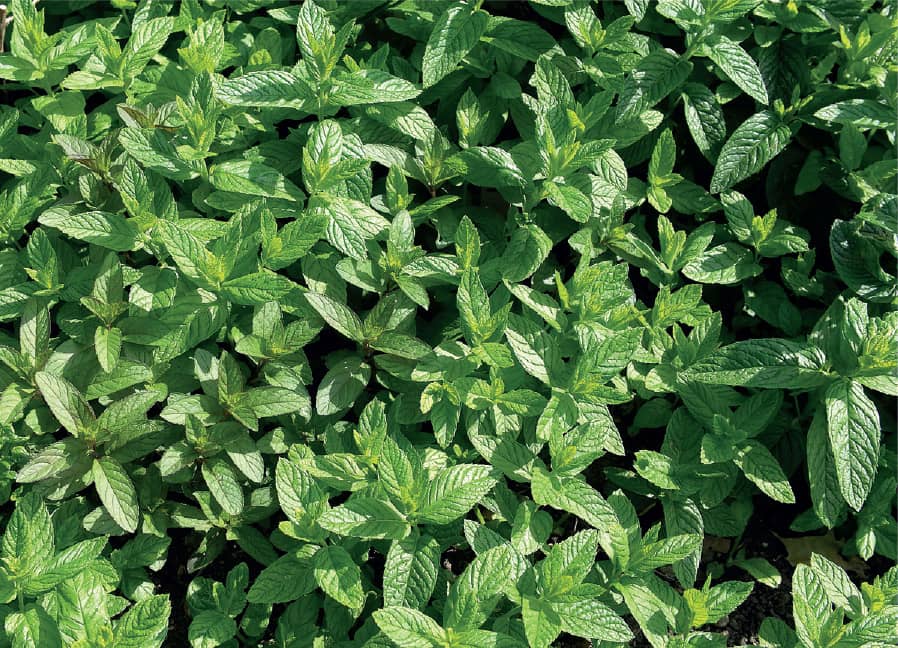SELECTING YOUR PLANTS

PLANNING BEFORE PLANTING

Growing your own plants from seed requires patience but it is the most rewarding way to garden.
Before you spend any money on plants, my advice is to give yourself some time to plan where and what you would like to grow. Checking that a plant will suit its chosen site and soil, as well as its function within your design scheme, is essential.
When putting together a planting scheme, first do some research and draw up a wish list. On a warm spring day when you want to be working outside, it can be very tempting to start a project by rushing off to the nearest garden centre and buying an array of mature flowering plants already in full flush. Although this will give you some instant gratification and temporary pleasure, it is the most expensive and least satisfying way to garden, and is likely to lead to disappointment if the plants are already nearing or just past their best. I have had my head turned many a time by a bright seasonal display and, while I am still a sucker for the occasional spontaneous purchase, I have learnt that a little patience and forethought goes a long way and saves money in the long run.
The early summer and midsummer projects for this book were planned three to six months ahead of time. I had a pretty clear idea of what I wanted to grow and which containers I would be using and I grew as much as possible from seed. The difference in price between a packet of seeds, from which you can grow many individual plants, and those that are fully grown is enormous. You can either pay a nursery or garden centre to do the work for you, or do it yourself – I personally find growing plants myself much more satisfying.

Visiting flower markets gives you ideas of what to grow yourself in a small cutting patch.
Sowing success
I used to think that raising flowers from seed would be too fiddly and time-consuming, but the more I do it, the more I realise that it is actually very straightforward. You will need to set aside some time, but it is really easy and offers you the chance to grow a wider range of plants and flowers and to inject your own personality into your planting schemes.
Many of the cottage-garden, old-fashioned blooms that I love to grow for my floristry work are not easily available at the garden centre, but their seeds can be purchased from independent specialist suppliers. Once you have grown them the first year, you can then collect the seeds from the flowers to resow the following year and make your plants really earn their keep (see here for advice on how to sow seeds).
THE VALUE OF TREES

Trees are vital to the health of our planet and our personal well-being.
If you are lucky enough to have the space, I would urge you to plant a small tree or two. The more trees we plant collectively in our urban gardens, the more we will be contributing to the long-term health of our planet and the kinder we are being to ourselves and each other.
Trees provide elegant structural features in small urban gardens, and while we may include them for their beauty, they also fulfil a range of important ecological functions. Trees are vital to the environment. In built-up areas they significantly improve the air quality by absorbing pollution. They capture carbon and tap the soil for nutrients that are then recycled back into the earth as fallen leaves. They help to moderate climatic changes too, and just one tree can provide local flood protection. In hot weather trees function as natural air conditioners and keep our towns and cities cooler, while in winter, they act as insulators, protecting buildings and people from extremes in temperature.
Although you may think planting one tree will not make much of a contribution, if you multiply the number of single trees that could be grown in every small front or back garden, they soon add up and will make a huge difference.
Not only will a tree provide shade, privacy, shelter and a sense of security, but when used as part of a wider planting scheme, it also acts as a feature point or full stop. A tree encourages us to look up and beyond our immediate surroundings – something we often neglect to do. And when we lift our eyes to the sky, our personal awareness of our place in the world is heightened; a tree can literally be quite grounding. Select a variety that has year-round appeal, offering blossoms in spring, coloured foliage and fruit in autumn, and a striking outline in winter.
Decorative trees
When selecting a tree for your garden, do your homework and ensure you choose the right tree for the right place – it will save you making an expensive mistake. A tree costs a lot more than a packet of seeds so choose carefully. Look at small trees growing in your neighbourhood – any planted tree pits will also show what will thrive beneath them – and familiarise yourself with the names of a few favourites.
If I had to choose just one tree for a small city garden it would be the all-performing Amelanchier lamarckii, with its white starry flowers followed by summer fruits, and gorgeous bronze-tinged new foliage that turns a deeper red colour in the autumn. I also love the bright white-stemmed Himalayan birch (Betula utilis var. jacquemontii). Others worth considering are crab apples (Malus), rowans (Sorbus) and hawthorns (Crataegus), which all produce bee-friendly blossom in spring and autumn fruits to feed the birds.

A mature urban garden with several small trees creates a beautiful green sanctuary in the city.
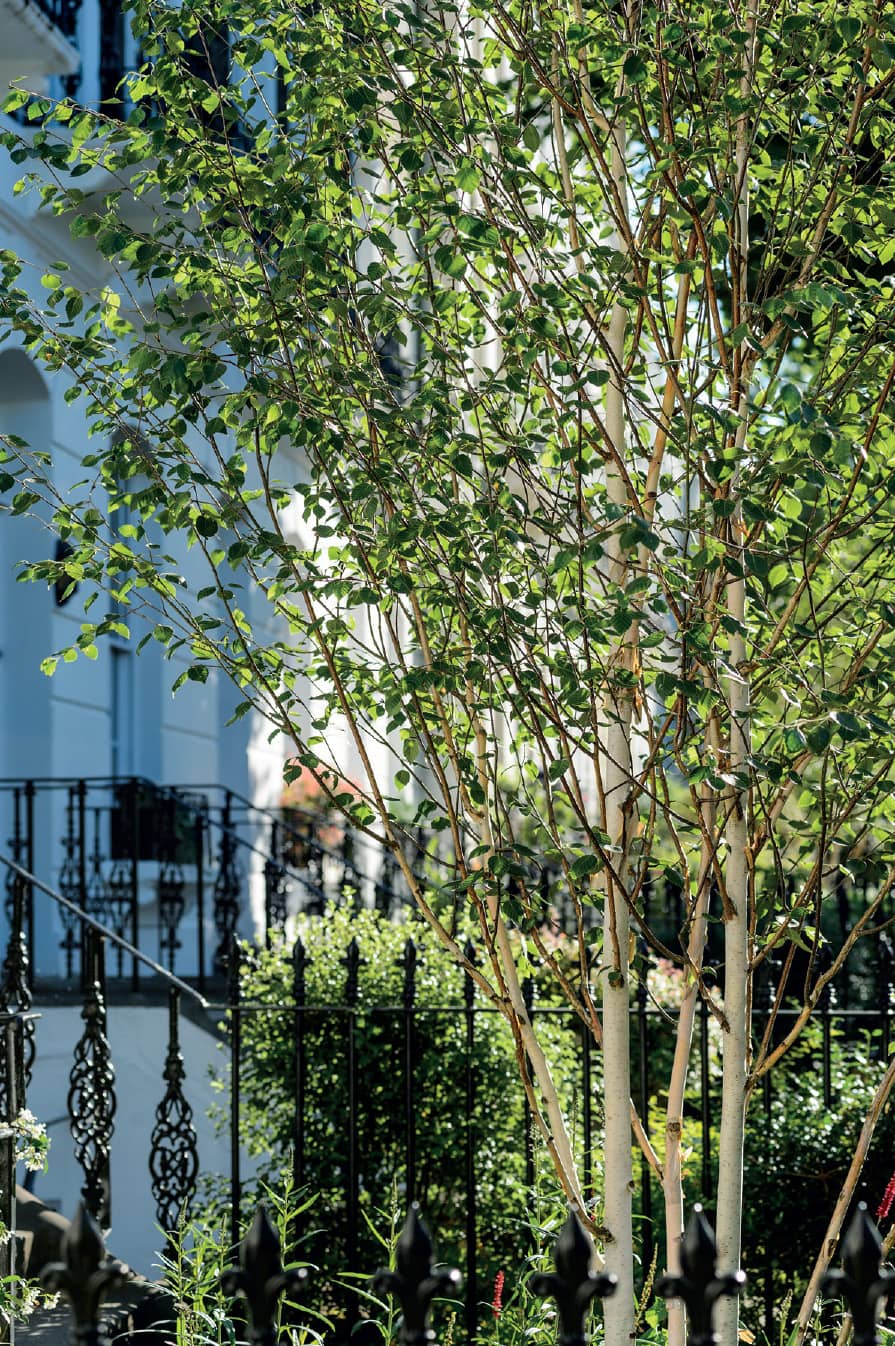
A Himalayan birch tree is a living artwork with its exquisite papery gleaming white bark.
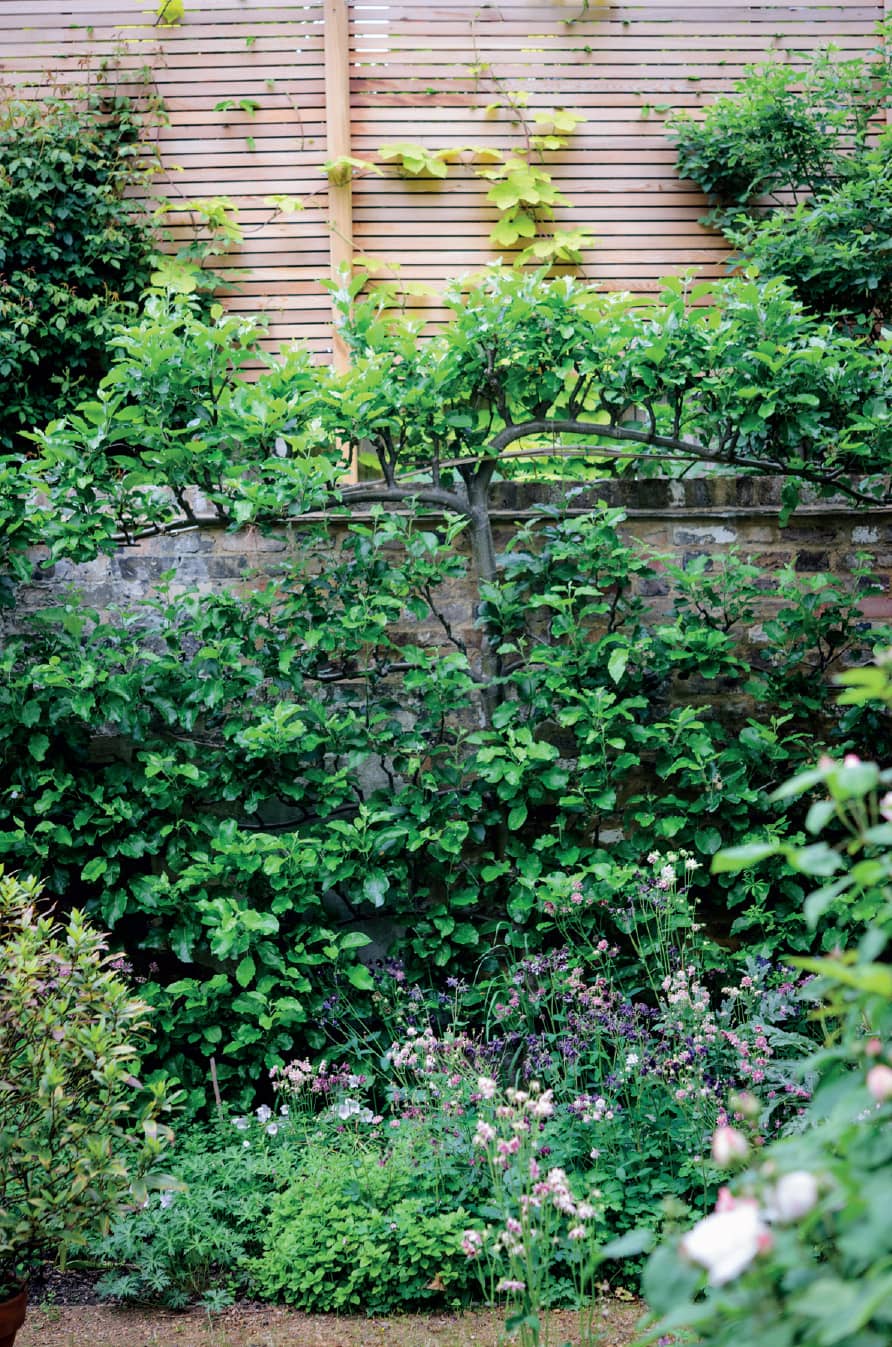
Espaliered trees trained along wires fixed to walls and fences make leafy backdrops.
SHRUBS FOR SMALL SPACES

Shrubs with colourful spring flowers in containers bring spots of seasonal colour to small spaces.
Annual and perennial flowers may be the stars of the show, but shrubs will provide structure, form and colour when other plants have faded. Look for shrubs that perform in each season, and offer handsome foliage, colourful stems, or pretty flowers that sustain year-round interest.
If you have a group of pots, it is a good idea to devote one to a shrub that has a permanent presence and can provide a backdrop to the other seasonal flowers as they come and go, offering interest when little else is in bloom.
You can clip and shape slow-growing evergreens yourself or splash out on some pre-trained topiary that will give your space instant definition. Many garden designers opt for evergreen box balls and cubes (Buxus sempervirens) because they are so well-behaved and easy to maintain. Box needs a yearly hair-cut but otherwise makes few demands; just keep an eye out for the fungal disease box blight, which causes the leaves to yellow and die. Boxed-leaved holly (Ilex crenata) is a good alternative if blight strikes. Its small glossy green leaves are equally good for clipping and it retains its shape for a long period. Both provide a green foil in a mixed planting scheme or a strong visual focus.
Flowering shrubs for small spaces include Hydrangea macrophylla, which has year-round appeal – its dried flower heads remain on the plant in winter and also make beautiful indoor displays. Mexican orange blossom (Choisya ternata) is another good choice for a container – I use both the flowers and foliage in my arrangements.

A dwarf lilac tree offers delicious scent in early summer.
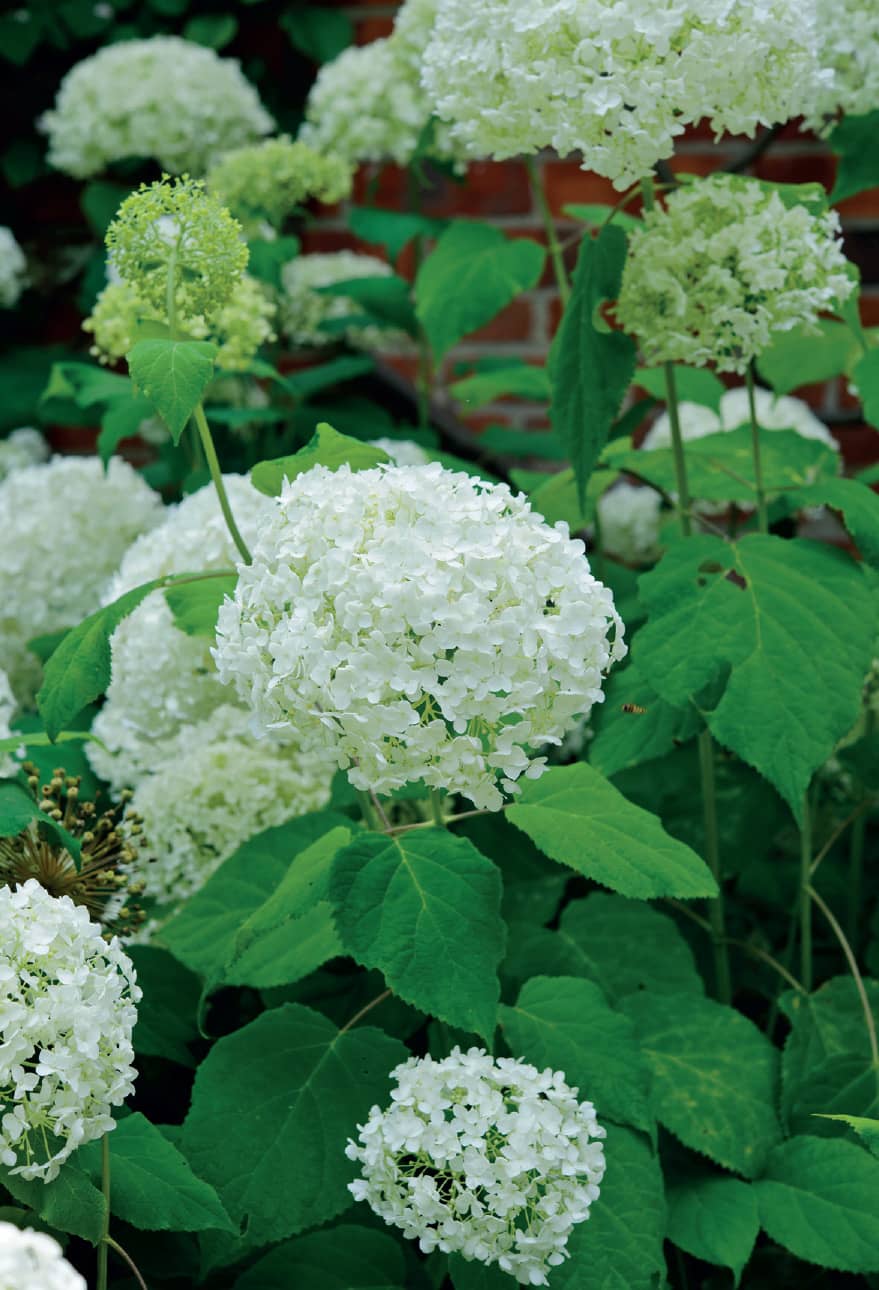
Hydrangea macrophylla summer blooms add drama.
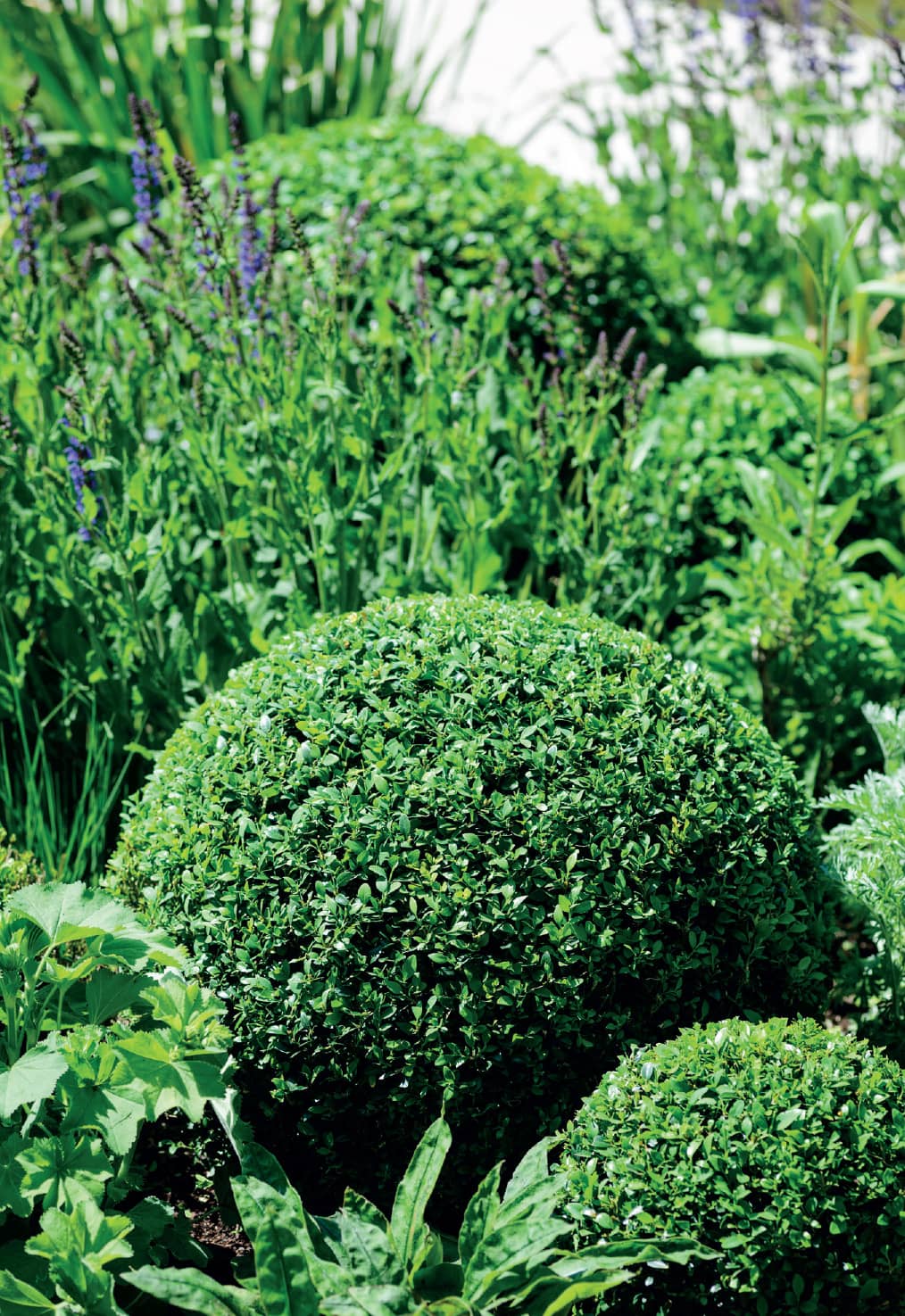
Clipped box balls offer evergreen structure and form.
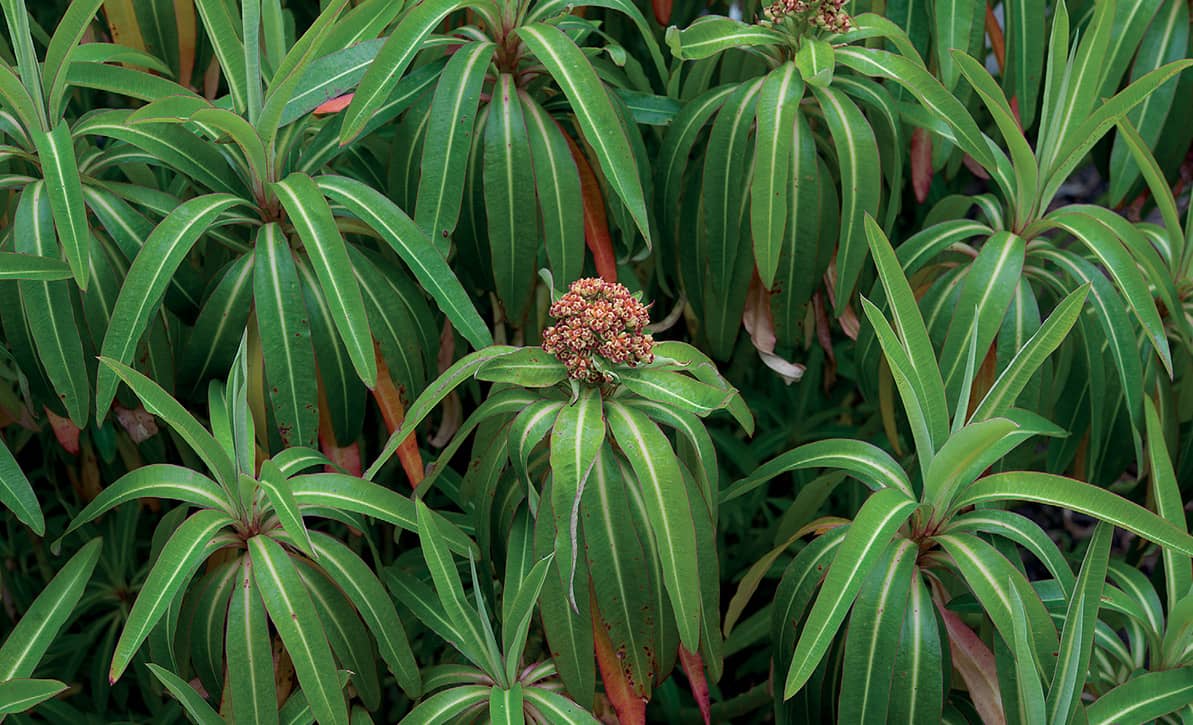
Honey spurge (Euphorbia mellifera) has scented flowers as well as finger-like foliage.
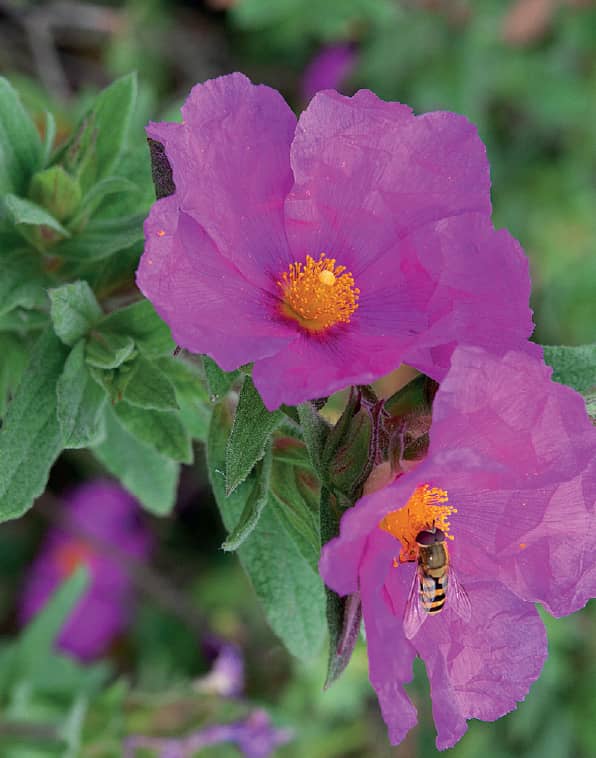
Rock roses (Cistus) produce papery flowers all summer.
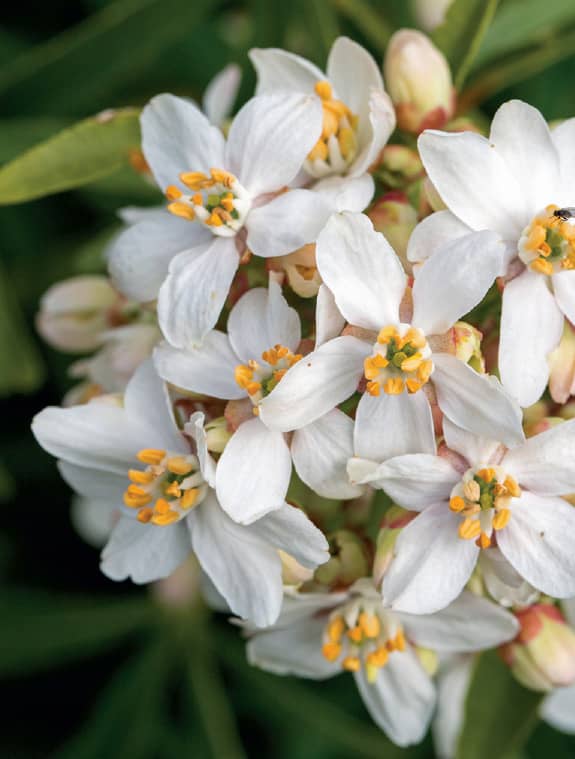
Mexican orange blossom (Choisya ternata) makes the perfect filler for a mixed bouquet.
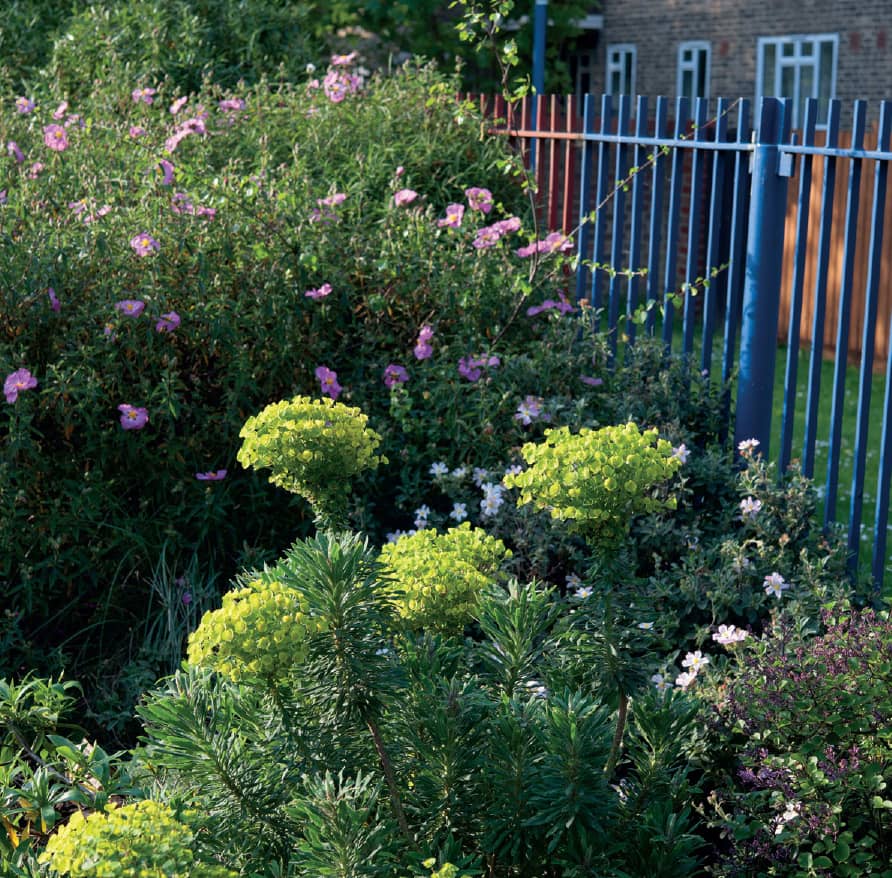
The lime green bracts of a Euphorbia in spring are a head-turner in a municipal planting scheme.
CHOOSING CLIMBERS

Ivy creates a verdant backdrop, attaching itself to any surface; cut it back annually to keep it in check.
In a small, enclosed space, climbing plants are some of your best allies; I would much prefer to see a wall or fence covered in glossy green ivy leaves than left bare and soulless. Create a verdant backdrop by clothing courtyard, patio or garden boundaries with beautiful climbers.
Evergreen climbers, such as ivy, are a good choice for small spaces, as they offer year-round colour and the perfect habitat for birds and other wildlife. Ivy also attaches itself to its host surface with tiny rootlets and requires no help from you to climb. Climbing hydrangeas (Hydrangea anomala subsp. petiolaris) do this too, and although they are deciduous and much slower growing, they provide an elegant background when fanned out against walls, and do not cause any damage to mortar. Perfect for growing where little else will thrive, they bear heads of lacy white flowers in summer and will cover a dark wall with beautiful heart-shaped bright green foliage for six months of the year.
Support systems
Most other climbing plants need an artificial support to help them climb. You can install trellis or horizontal panelled fencing on your boundary and plant climbers about 25–30cm (10–12in) from it to create a green wall. If installing trellis is not feasible, fix evenly-spaced horizontal wires to walls and fences or buy individual plant supports to use over or behind large containers.
You may have to tie the stems of climbing plants on to their supports at first, but in the majority of cases, they will soon start climbing on their own, their twining stems twisting and coiling around anything they touch. Roses are an exception, and even mature stems will need to be tied on to a support, unless they are weaving through a shrub or tree, where their thorns will hook onto the branches to help them climb.
On balconies and terraces plant a selection of flowering climbers, such as clematis, passion flowers and honeysuckle. In a larger space, try growing them through a tree or tall shrub; I like to thread clematis through rose bushes too. You can create a co-ordinated look by painting trellis, fencing and other outdoor woodwork in the same colour; paints and stains will also prevent these features from rotting if applied every year or two.

Climbing roses entwined with clematis is a classic combination.
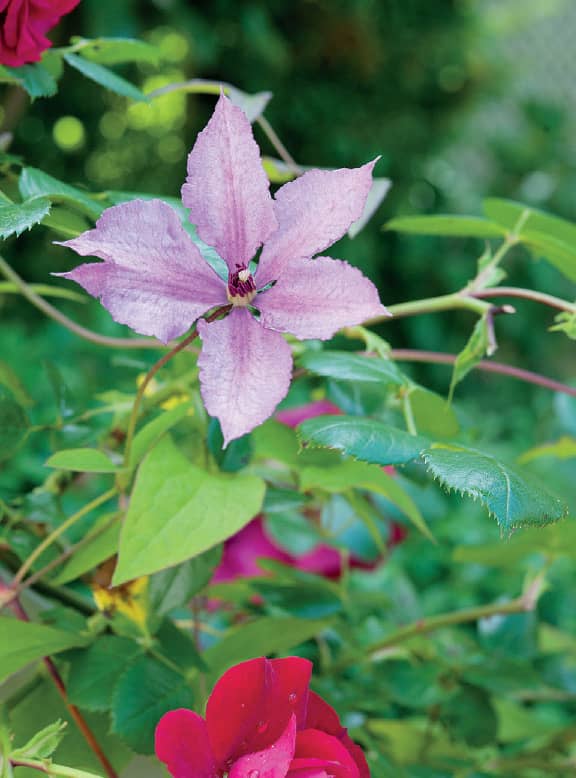
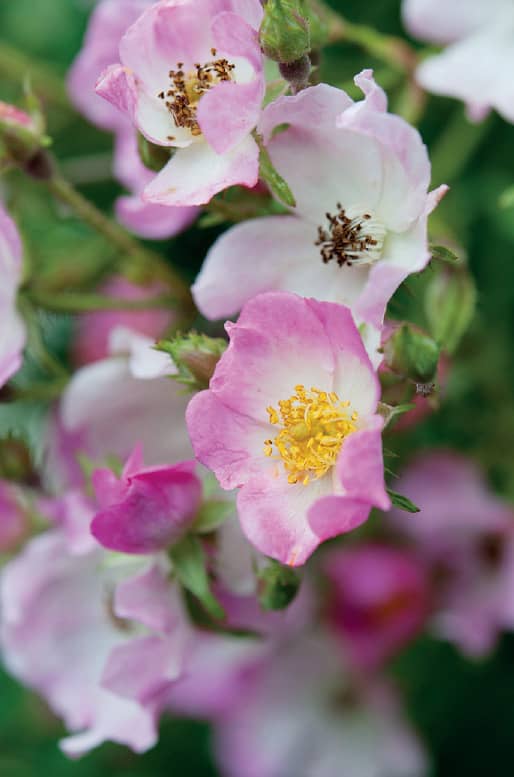
Rosa ‘Blush Rambler’ is perfect for a tiny space, with flowers reminiscent of wild roses found in hedgerows.
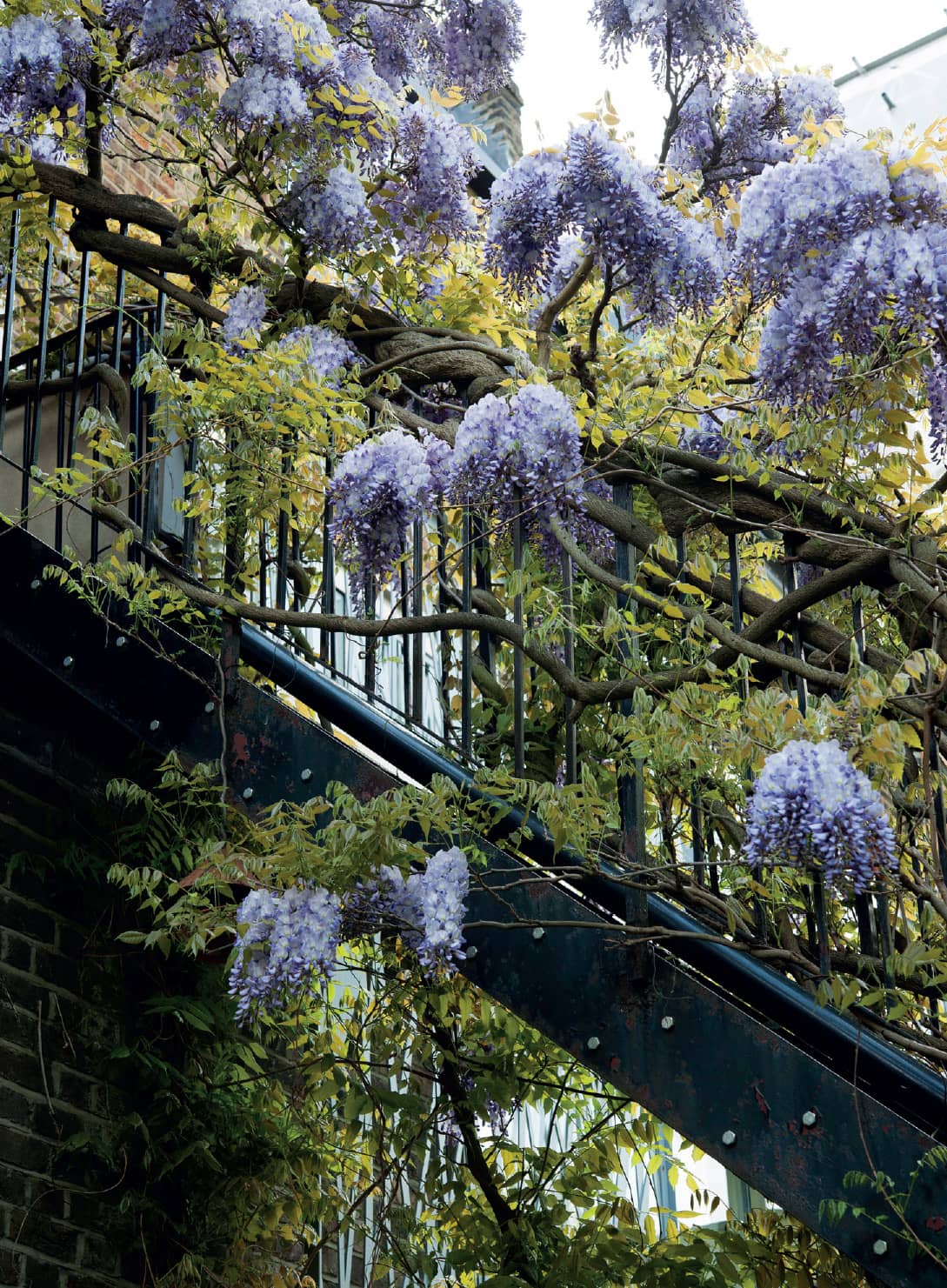
Chinese wisteria (Wisteria sinensis) puts on an annual spectacle of pendent sweetly perfumed purple or white blooms.
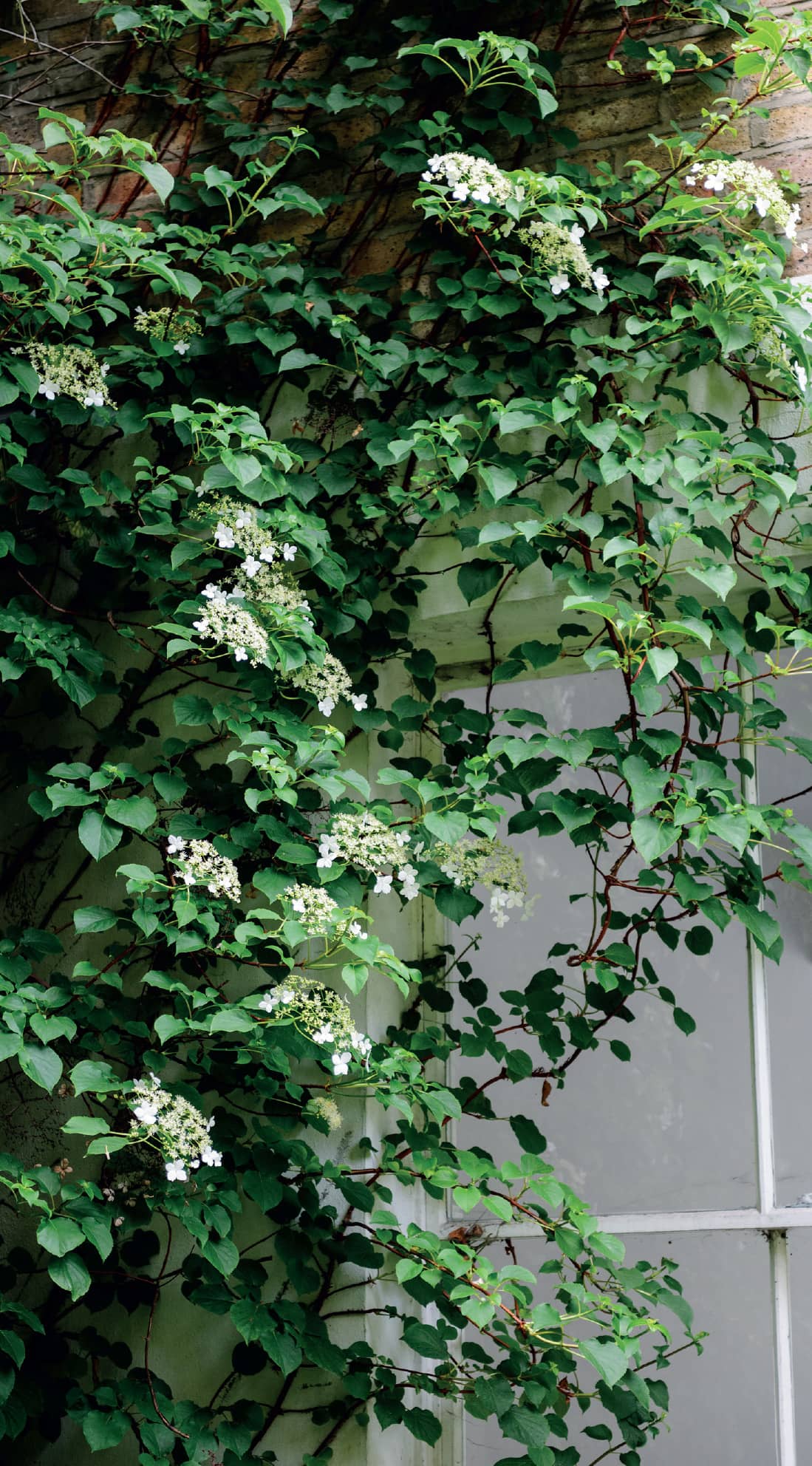
Climbing hydrangeas will grow rampantly to clothe the walls of a house or shed with their large white blooms.
GRASSY EFFECTS

Quaking grass (Briza media) is incredibly easy to grow from seed. Its tear-shaped flower heads look like little water droplets when they catch the light.
Grasses are the stalwarts of the urban garden. Evergreens offer year-round colour, while the leaves, flowers and seedheads of deciduous types provide late summer and autumn interest. Their rustling stems help camouflage background city noise, too, and the effect is wonderfully calming.
Grasses offer the urban gardener many benefits. As well as providing colour and texture, they are incredibly tactile and it’s hard to resist reaching out to stroke their feathery plumes, which helps to soothe my frayed nerves after a stressful day.
Grasses may be the comfort blanket of the plant world, but they are also blessed with striking good looks and work hard to earn their place in a small space. Some, such as the stunning Anemanthele lessoniana, are evergreen; its tall arching clumps of foliage actually turn from green to a beautiful coppery palette of oranges, yellows and reds in the autumn and winter. Many others, including Miscanthus and some Pennisetum, are deciduous. If you have room, plant a selection. Try the compact Miscanthus sinensis ‘Starlight’, which bears pebble-hued fluffy tufts in autumn on hip-height mounds of thin silvery leaves, or opt for Pennisetum alopecuroides ‘Cassian’s Choice’, which replicates the sound of running water when its leaves rustle and sway. The dried stems and seedheads of deciduous grasses overwinter too.

The tall plumes of the Korean feather reed grass (Calamagrostis brachytricha) make you want to reach out and stroke them. Their gentle rustling in the breeze helps to soften the background noise of the city.
Pots of plumes
Since all grasses have shallow root systems, they do well in pots and containers. You need to check their heights, however, as some can grow up to two metres (7ft) tall – ideal for screening but they would look out of place in a window box. If space is tight, then mix a packet of Briza media seed with some annual flowers. This gorgeous little plant, known as quaking grass, is a semi-evergreen with tiny teardrop flowers that bob in the breeze above a clump of green foliage. A favourite among flower-arrangers, it dries well and self-seeds profusely – I now have it growing all around my garden from one initial planting.
Another bonus is that grasses require little maintenance. In spring, simply comb through evergreens with your fingers or a kitchen fork to remove any dead stems, and cut down deciduous species to the ground – they will soon shoot up again to fill the gap. Grasses can become addictive and I recommend buying them from specialist growers, who offer the widest choice.
IDENTIFYING ANNUALS, BIENNIALS & PERENNIALS

Annuals grown from seed, such as scabious, will spread around if the seed heads are left to mature.
Once you start growing your own flowers you will soon learn how they fall into different groups. There are three main categories, which reflect a plant’s particular habit and lifespan, and knowing what’s what will help you to choose those that best suit your space and chosen design.
Annuals
Many of the flowers that I grow from seed are known as “annuals”. Sweet peas are a good example. These plants complete their whole life cycle within one year, germinating and putting on enough growth to flower profusely and set seed again within 12 months or less. One of the best reasons for growing annuals in small spaces, particularly in pots, is because they put all their energy into forming flowers rather than developing deep roots and therefore require shallow planting. Pot-grown plants also tend to flower more quickly as the compost warms up faster than the soil. Annual container planting keeps things exciting too – when a display is past its prime you can remove or hide it and bring something else to the fore to shake things up.
Annuals are split into two types: hardy and half-hardy. Hardy annuals survive temperatures below freezing and can be sown in autumn or spring. If it is very cold, a hardy annual planted in the autumn will become dormant in winter and only start growing again when it warms up. Half-hardy plants need to be protected from cold weather and die when temperatures hit freezing. Either sow their seeds when all risk of frost has passed, or start them off indoors on a windowsill.
Biennials
These plants form roots and foliage in the first year after germinating, and then flower and set seed the following year. Good examples of biennials are wallflowers and foxgloves. Seed packets will indicate whether plants are annual or biennial and offer guidance on sowing them. I grow both, but if you are only creating a temporary garden, then stick to annuals and you will reap the rewards more quickly.

Foxgloves are biennial plants but they self-seed to provide flowers year after year.
Perennials
Flowering plants that live for more than two years are known as “perennials”. They can be divided into two groups: “short-lived”, which survive for about three or four years, and “long-lived”, which generally live for at least five years. Perennials can also be tender or hardy. A tender perennial will not survive temperatures below freezing. The top growth of most hardy types dies back in the winter while the roots survive underground. Many perennials spread over time, so you need to check these details on the plant labels if you are planning to use them in pots or tiny spaces. You can also dig up clumps and split perennials in autumn or spring to make more plants. If you wish to create a temporary container display, treat your perennials as annuals, removing them after they have set seed and transplanting them elsewhere.
Perennial plants with a tendency to self-seed are true-gift-givers. Even if you haven’t time to collect and resow seed yourself, there are a huge number of plants that will save you the bother. Aquilegias and Verbena bonariensis will self-seed in every nook and cranny available – to the point where you are editing them out and donating them to your friends and neighbours. If you allow nature to give a helping hand you will end up with a space that looks completely naturalistic, even in the middle of a city.
Interlocking swathes of perennials, known as prairie planting, has become hugely fashionable over the last few years. Look at schemes by Piet Oudolf, such as the High Line in New York, or Sarah Price’s planting at the Olympic Park in London, for ideas on how these perennial designs work. The trick is to choose a small number of different species that suit your site and soil, then set them out in groups of the same type, and repeat these throughout the garden. The result looks very naturalistic, and can be a sustainable way of gardening in a small urban space.
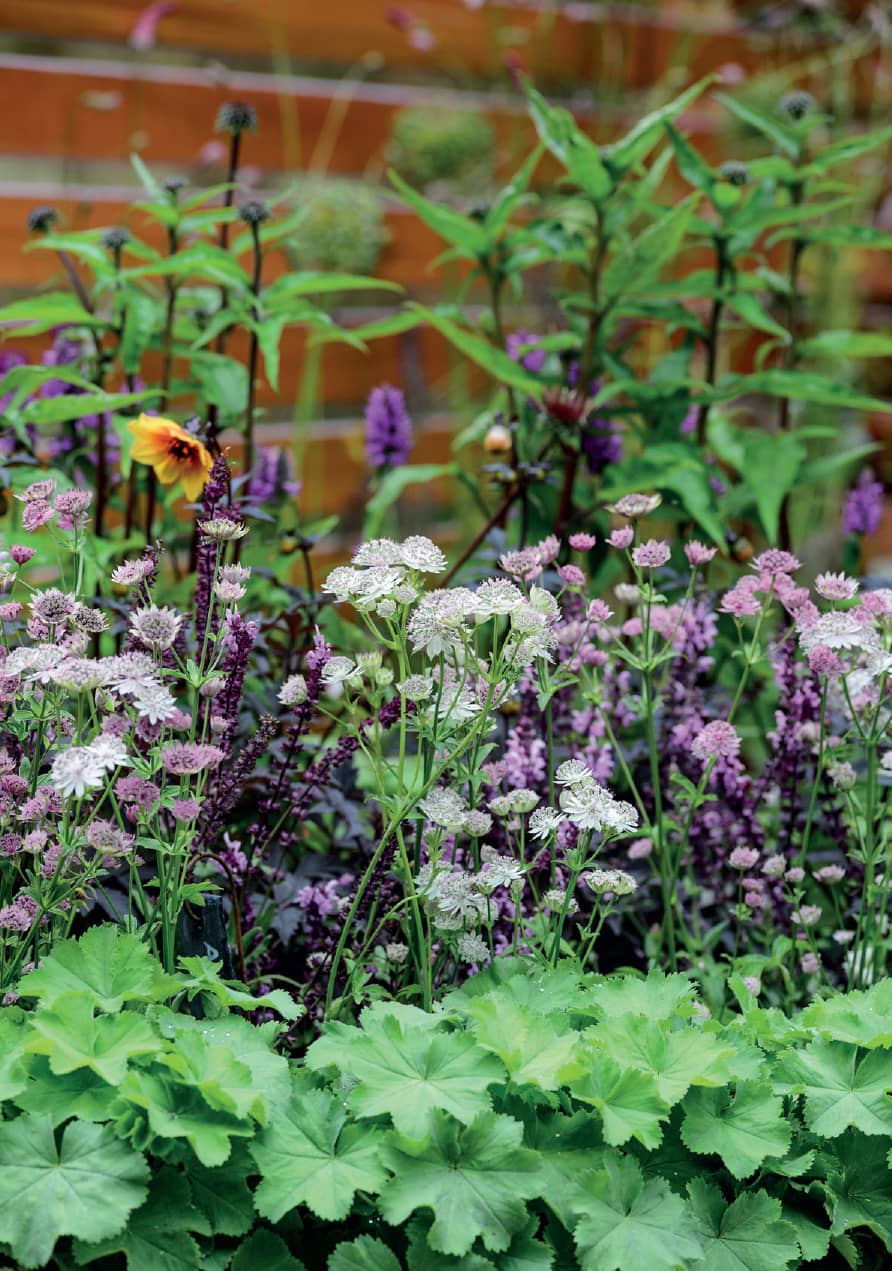
A mixed scheme of astrantias shows several different-coloured varieties of this perennial.
SOWING FROM SEED

The easiest way to grow hardy plants from seed is to sow where you want them to grow, but raising them in pots indoors can increase your success rate.
Direct sowing
If you sow hardy annuals, such as Ammi majus, larkspur, scabious, cornflowers (above) and love-in-a-mist, in autumn they will be in flower by early summer the following year. When sowing in spring, wait until the soil surface is warm to the touch. In either case, make shallow drills with a cane and sprinkle seeds thinly directly onto the soil. Then cover them with a little more soil (check seed packs for recommended planting depths). This method allows you to clearly see the difference between your flowers when they emerge and weed seedlings.
When sowing half-hardy annuals and perennials directly outside, wait until there are no frosts. This applies to cosmos, tobacco plants, China asters, and didiscus.
Sowing in pots indoors
To steal a march on germination times you can start both hardy and half-hardy annuals on a windowsill indoors, alongside perennials such as astrantias, penstemons and dianthus (see right). Keep them under cover until any chance of frost has passed and transfer them outdoors for a few hours each day until the weather is warm enough to also leave them out at night.
STEP-BY-STEP
How to plant from seed
If you are sowing indoors you can buy seed trays and mini troughs, or recycle plastic fruit punnets, egg boxes or even ice-cube trays. Also try yoghurt pots and takeaway coffee cups for individual seeds, and in all cases use good quality seed compost. For convenience, and because I like its bright colour, I am using a plastic trough with a built-in water reservoir for these German pinks (Dianthus carthusianorum) and I have also transplanted some seedlings into small pots. Wild flowers in their native habitat in Europe, these pinks also suit containers in an urban space. They are members of the carnation family but with smaller, compact flower heads that are deliciously scented, as well as being edible. Sow these hardy perennials under cover between late autumn and late winter or early spring for a lovely show of blooms in the summer.
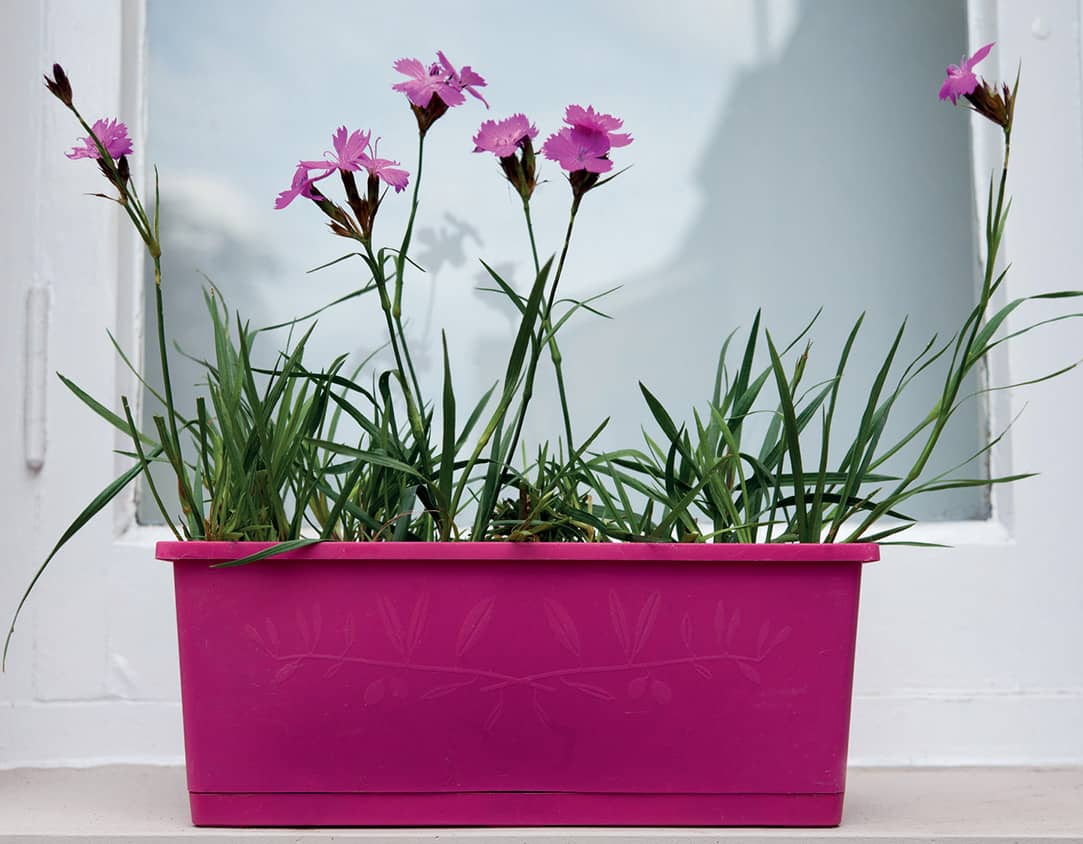

1.
• Fill the trough almost up to the rim with seed compost.
• Press down the compost gently to form a level surface. Using a pencil, or your finger, trace along the centre to create a depression roughly 1cm (1/3in) deep. Sprinkle seed thinly into the depression.
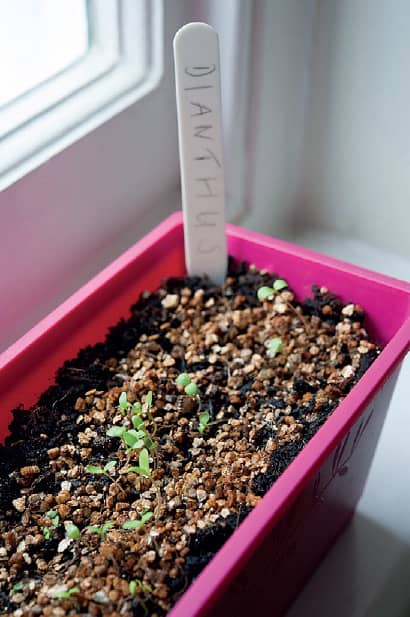
2.
• Smooth the compost over the seeds and then cover with a layer of vermiculite to help keep them moist. Label with the plant name.
• Place the seed trough in a light, warm area indoors, such as a windowsill, but keep your seedlings out of direct sunlight.
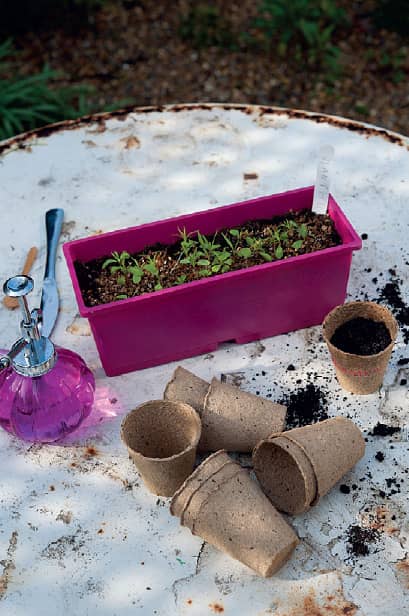
3.
• Water gently and regularly but do not flood. On this tiny planting scale, I find it easier to use a misting bottle or spray, rather than a watering can or jug, in order to control the water distribution and to avoid dislodging the seeds.
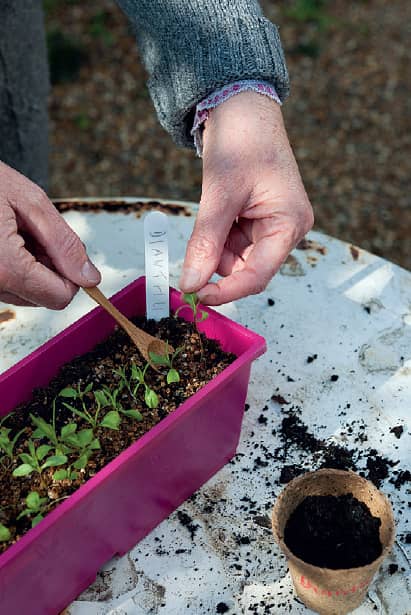
4.
• Germination will usually take place to great excitement within ten days to two weeks.
• When the plants are about 5cm (2in) tall and have developed a few sets of leaves, thin them out by removing congested seedlings to create enough space for the remaining plants. Here I have left six evenly spaced seedlings in the trough, and transplanted the others to individual pots.
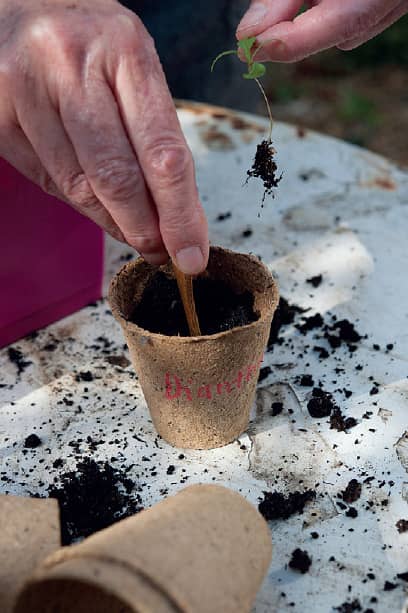
5.
• To transplant the excess seedlings, fill a few small pots with potting-on compost. Make a hole in the compost with your finger or a blunt pencil.
• Use a small spoon or a butter knife to remove the tiny roots without damaging them. Then, holding the seedling by its leaves, place it into the hole in the compost, firming around the roots gently. Moisten with a mister and label the pot.
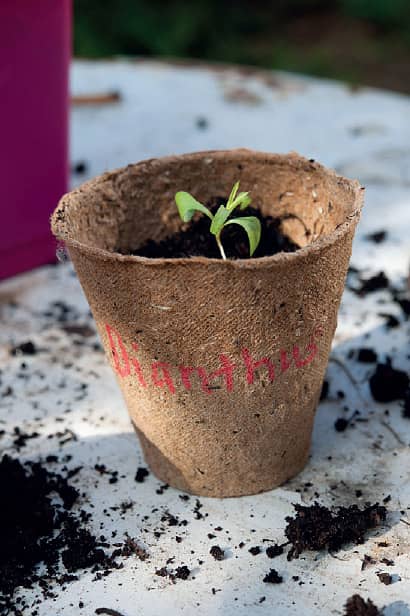
6.
• I have used 6cm (21/2in) peat-free fibre pots to transplant my dianthus. These can eventually be planted in their entirety directly into the ground or into a much larger pot.
• Keep your seedlings undercover until the frosts have passed, and transfer them outdoors for a few hours each day until the weather is warm enough to leave them out day and night.
BUYING SEEDLINGS & BEDDING PLANTS
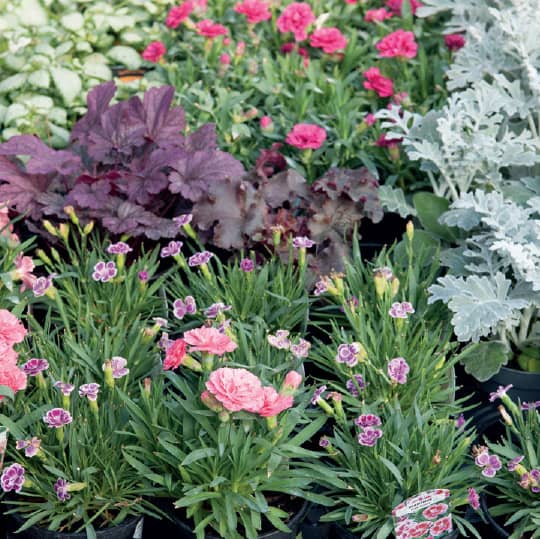
Pots of seasonal bedding plants offer the opportunity to create an instant garden.
Although I try to grow as much as possible from seed, limited time and space inevitably means I am unable to cultivate everything myself. My next option is to buy seedlings or young plants, known as plugs, which I grow on, or bedding that offers instant gratification.
Seeking out seedlings
There are many specialist growers and nurseries that supply mail-order seedlings, and it is more economical to buy a box of baby plants and nurture them yourself than to purchase them fully grown. Seek out online companies or visit those open to the public; some are open for a few days each year to showcase new varieties. For inspiration, you can also visit open gardens, such as The Beth Chatto Garden and Great Dixter, which have nurseries attached to them.
Other sources of seedlings are local plant fairs or gardening neighbours who may have some surplus. If you are in London, Columbia Road Flower Market is well worth a visit, but most street and farmers markets offer a good selection and provide an opportunity to chat to the growers who can offer you advice.

Flower markets, such as this famous one at Columbia Road in East London, allow you to buy plants directly from growers, and offer a more cost-effective way of purchasing lots of plants for a new garden.
Filling gaps with bedding
There is a certain amount of snobbery in the horticultural world attached to so-called bedding plants. They are really a mix of annuals and short-lived, often tender, perennials bred especially for their colourful displays, and they are ideal for pots, containers, hanging baskets and gaps in flowerbeds. They include begonias, petunias and busy lizzies, which you will recognise as the decorative summer plants seen in city parks and town centres, where they are generally planted together in a froth of vibrant multi-coloured mixtures.
For the purposes of creating harmonious, elegant designs, it is tempting to dismiss bedding, but these plants can be worth their weight in gold if you use them sparingly as fillers in pots, or pick out a carefully edited selection of trailing varieties to create your own beautifully styled hanging garden (see project shown here). The benefit of bedding is its long flowering period, offering displays that continue up to the first frosts in autumn. You will find a good selection for sale at your local garden centre, DIY store, or supermarket, which will be ready for planting outside in early summer. If you can resist them when they first appear, you can often pick them up for much lower prices later in the season.
GROWING BULBS, CORMS, RHIZOMES & TUBERS

A drift of bulbs, including dwarf narcissi and crocuses, welcomes in the spring.
Harbingers of spring, bulbs bring colour to the garden when little else is in bloom. Some bulbs flower in late summer and autumn, helping to fill gaps that appear at this time of year, while a hardy few show their faces in the depths of winter, shrugging off the snow and ice.
Starting with snowdrops in late winter and following through with a succession of daffodils, grape hyacinths (Muscari), bluebells and tulips – these familiar flowers of the spring garden herald the new start of the gardening year and its boundless possibilities.
What is a bulb?
A bulb is essentially an energy storage unit, made up of fleshy, fibrous material with a growing point at its centre. Think of an onion cut in half lengthways and you will get the picture. If you leave an onion for long enough in the vegetable rack it will start to grow thin green leaves of its own accord, and this is what a bulb does underground. If you plant an onion once it has sprouted, it will indeed form a flowering stem, just like its beautiful cousins, the pompom-flowered ornamental alliums.
Corms, rhizomes and tubers, while different in appearance and structure to a bulb – a rhizome, for example, is a swollen underground stem – are all food stores and perform in a similar way to produce their flowers and leaves.
Bulbs come in a variety of shapes and sizes and, generally speaking, the larger the bulb the bigger the flower head, so if space is at a premium, take this into consideration. But limited room does not mean it is impossible to grow bulbs; it is more a question of how many and what you grow them in. Left to their own devices, many bulbs want to “naturalise”, which means they will multiply and spread themselves around. A profusion of flowering bulbs looks fantastic in a wide, open space or a woodland glade – there is nothing more stunning in early spring than a carpet of crocuses pushing their little heads through the soil. In a small area, however, the answer is to grow them in pots, which you can swap around as one type fades and another comes into bloom. Or plant a single large pot as a ‘bulb lasagna’ made up of different layers, where one species will flower directly after another to provide a continuous display.
Planting times
Just as you need to think a few months ahead when planting seeds, you must plan in advance for bulbs. Spring- and early summer-flowering bulbs should be planted from autumn to early winter, and plant those that bloom in midsummer and autumn in spring. You will see sacks or bags of spring bulbs in supermarkets and garden centres from late summer onwards, and this is the time to start planning. Scented hyacinths forced indoors for early flowering are very easy to grow (see project shown here) and you can do the same thing with grape hyacinths (Muscari), which look lovely potted individually in a row. Deep bowls of paperwhites and other miniature daffodils, followed by snake’s head fritillaries, will take you through to late spring. Follow these with a pot of perfumed lily-of-the-valley. Given as a traditional gift to celebrate May Day in Europe, if you leave it on the doorstep or in a stairwell the blooms will fill you with pleasure as you come and go. For a larger display, pack a punch with tulips planted in a big zinc container or wooden planter. Mix two or three varieties in harmonious colourways – ‘Black Parrot’, ‘Queen of Night’ and ‘Burgundy’ produce an intoxicating wine-coloured combination.

Mini pots of grape hyacinths (Muscari) suit a tiny garden space.
Late-season blooms
Bulbs in summer and autumn have more competition from other blooms, although dahlias do their best to stand out from the crowd and provide a great show of exotic-looking flowers. Alliums, especially the smaller-headed Allium sphaerocephalon or drumstick variety, are good for small spaces as they are tall and slender. Agapanthus remind me of seaside resorts, but they work equally well in an urban environment, particularly in containers, as they like nothing better than being wedged tightly against each other. Crocosmia, with their burnt orange or red hues, bridge the gap between summer and autumn. They grow like a weed in my garden so need to be watched, but one or two corms will quickly form a clump and provide a dazzling colour combination when grown among dahlias in similar tones, such as ‘Jescot Julie’ and ‘New Baby’. Although autumn tends to make me feel wistful, I am convinced that a bright show of colour at the end of the growing season is nature’s way of keeping our spirits high.
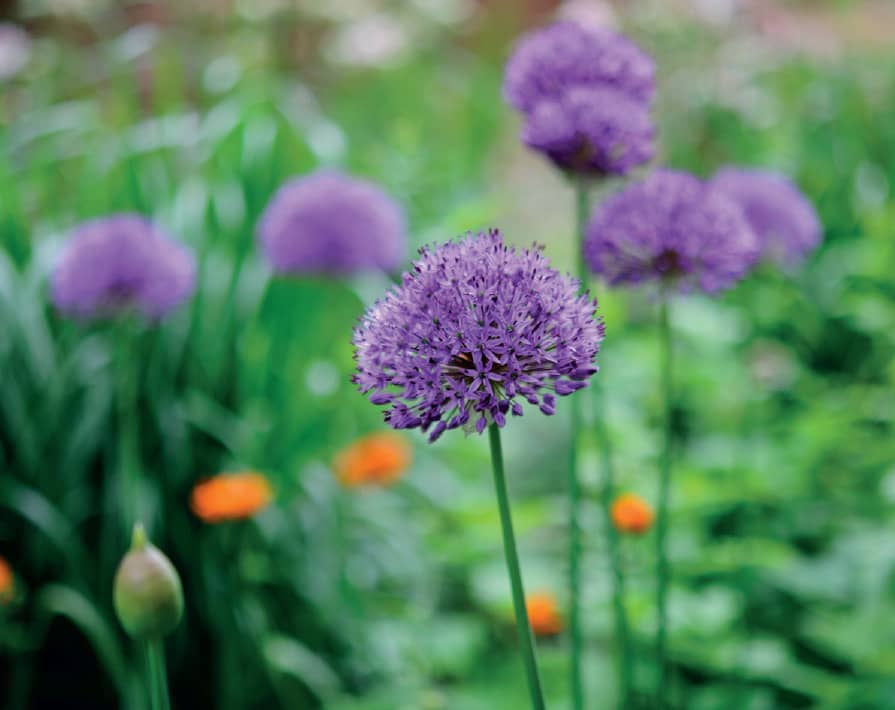
Purple pompoms of alliums make great cut fresh or dried flowers.
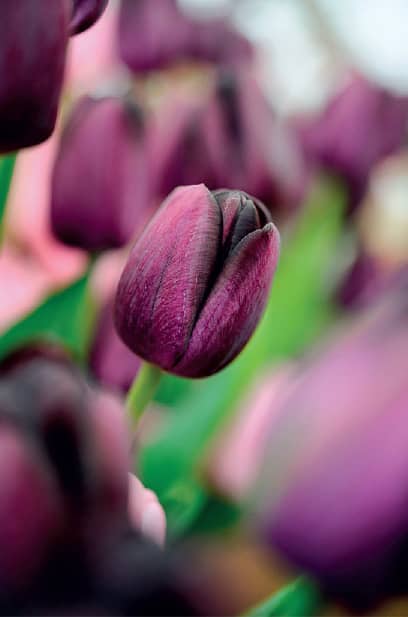
Tulipa ‘Queen of Night’ is perfect for a moody, sultry effect.
ADDING SCENT TO YOUR SCHEME
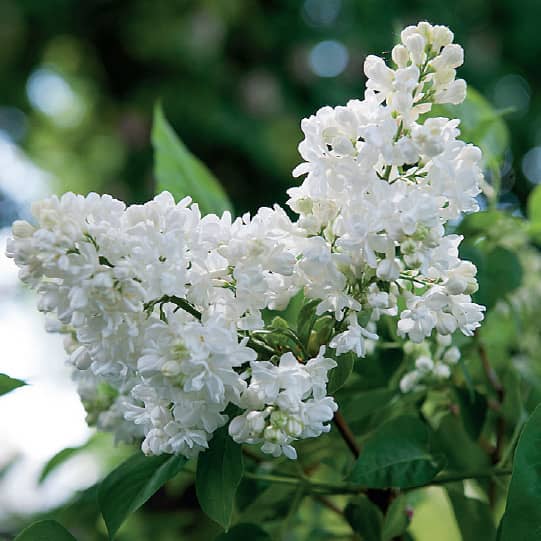
White lilac blooms inhaled up close will give you an instant high in spring.
For me, flowers and scent go hand in hand and I always include perfumed plants in my schemes. Sadly, the cut flower and horticultural industries seem to have made fragrance a bit of an afterthought, but there are still many gorgeous flowers that you can grow to fill your garden with scent.
I find it bewildering that scent is not one of the qualities plant breeders focus on when creating new plant ranges. Disease-resistance and bright colours seem to have become the holy grail for commercial growers, and many flower varieties produced for the mass market have lost their true scent through genetic manipulation.
Timeless perfumes
Historically, flowering plants brought us the first bottled perfumes and the use of plants in toiletries and cosmetics is age-old. They provided the scented oils and waters that were used as part of the ritual of adornment; the first lifestyle accounts on papyrus scrolls detail the harnessing of natural fragrances to cleanse the body and anoint the spirit.
From every culture since the Ancient Egyptians, plants and herbs have been used for their hygienic, medicinal and psychological benefits. Archaeological finds have unearthed ornate amphora or oil jars still impregnated with the original scent, which show how perfume was revered as a precious commodity. A gift from and to the gods, it was used to embalm bodies to ensure a peaceful afterlife. Incense, the natural resin from the Boswellia or frankincense tree, was harvested in its pure form, while the earliest manufactured perfumes were derived from the crushed and blended leaves and petals of scented flowers, before the first distillation processes were introduced in the 11th century.
The use of perfume for personal, religious and cultural purposes has always been with us and our powerful response to scent is wired into our brains. Our noses are incredibly sensitive and our sense of smell is many times more developed than our sense of taste. Linked directly to the limbic lobe of the brain where we also register emotions and memory, scents often evoke past events or places. Vivid recollections are reawakened by a smell already in our memory bank, based on childhood associations with the natural world. Equally, some perfumes just make us feel happy or at peace.
Given that it is no longer a requisite for daily survival, we are perhaps in danger of losing our full capacity to smell and there is a growing disconnect between flowers, their perfume and our ability to recognise them. Today’s cheap synthetic fragrances are largely bland and less a gift from the gods or Mother Nature and more a marketing dream. Growing your own flowers, however, goes some way to reversing this trend.

Scented stocks (Matthiola longipetala) help to fill a small space with heady early evening scent.
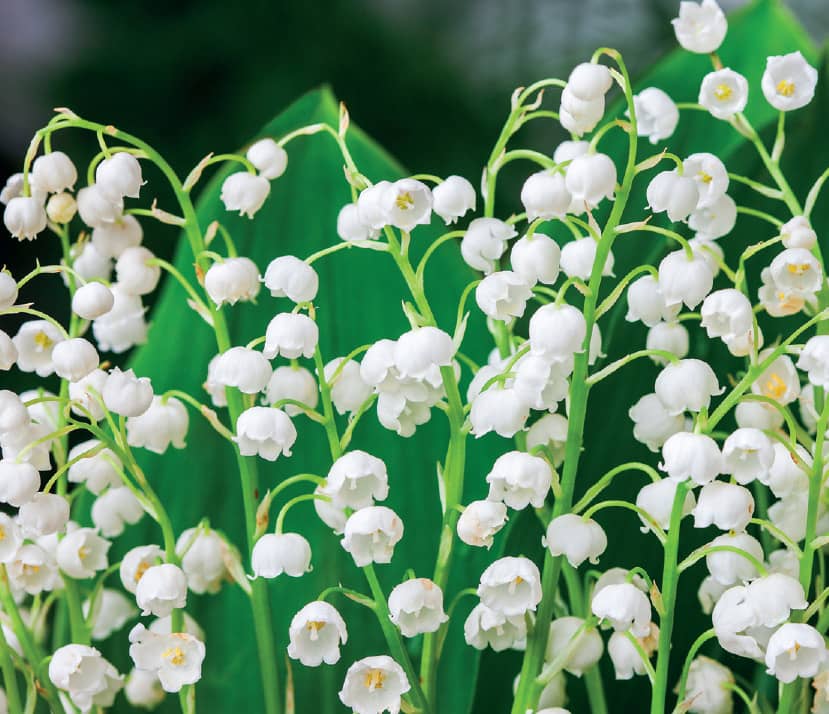
The fragrance of the dainty lily-of-the-valley (Convallaria majalis) is a gift of the gods.
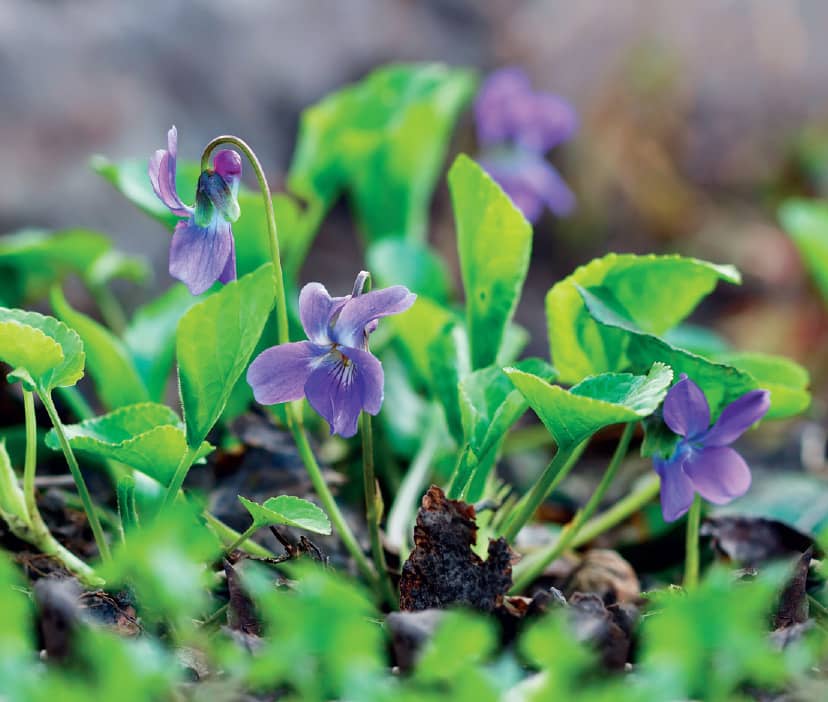
The tiny petals of sweet violets (Viola odorata) belie their intoxicating scent.
SELECTING FRAGRANT ROSES

Originally grown for their medicinal benefits, roses today are more commonly cultivated for their colourful flowers and intoxicating perfume. Some will bloom repeatedly throughout the summer and autumn, offering the urban gardener great value.
We only have to look at the original apothecary’s rose (Rosa gallica var. officinalis) and its various uses for evidence that historically these plants were widely cultivated for medicinal purposes. Their fantastic looks were secondary in those days, but we now grow roses in our gardens primarily for their beauty and delicious scent. Look out for the Rosa gallica ‘Versicolor’ (above) – a magical, bi-coloured white and red striped rose that looks as if it is has been lifted from the pages of Alice in Wonderland.
My obsession with rose scents began when I first started my floristry business. My intention was to offer bouquets of top quality, fresh roses, but I was disappointed to discover that most imported roses lose what little scent they may have after several weeks in cold storage. I began my quest to create a range of rose-scented products to accompany my bouquets, blending my own bath oils and candles in my kitchen. For a long while, the very fabric of the house seemed to be impregnated with the scent of roses, but it was only a couple of years ago that I took the plunge and started growing them in my garden.
Having always assumed that roses were fussy and difficult to grow and maintain, I have discovered the opposite is true, and I now realise that no flower garden, however tiny, is complete without at least one rose. More to the point, if you select a highly scented variety, one rose is all you need in an enclosed space.
I have selected some of my favourite scented roses on the opposite page. Others I would recommend include the white, repeat-flowering Susan Williams-Ellis, which has a traditional rose perfume; Summer Song, with its fruity floral-scented burnt orange flowers; and Sir Walter Scott – its blush-pink flowers and “old rose” perfume remind me of those my grandma grew.
GROWING THERAPEUTIC FLOWERS

Heads of dried lavender flowers keep their scent for months.
The power of plants to soothe the mind and body is well known, but experts are still not exactly sure why certain aromatic oils have a therapeutic effect. Nevertheless, it is a great idea to grow and use a few in your garden to enhance your sense of wellbeing.
The fragrances of certain plants have long been used as remedies to help us relax, calm our nerves, relieve tension and anxiety, aid sleep and, in some cases, alleviate depression. The centuries-old practice of aromatherapy involves inhaling these scents directly, bathing in their oils or massaging them into the skin. Therapeutic plants are also ingested in the form of a tea or tisane. Many are easy to grow in an urban garden, allowing you to take full advantage of their beneficial qualities.
Soothing lavender
To experiment with therapeutic plants in a small space I would suggest starting with a pot of lavender (Lavendula), a plant renowned for its aromatic qualities and as a powerful relaxant. It is extremely easy to grow in a container; its only requirement is plenty of sunshine. There are many varieties available and different types flower at different times throughout the summer and autumn, starting with the French lavenders early in the season and ending with those that fade with the first frosts. If the scent appeals to you, why not create a mini lavender garden with a colour scheme that ranges from pale lilac to deep purple? My favourite variety and one of the best for impact in a small space is the English lavender, Lavandula angustifolia ‘Hidcote’. Stunning as a single specimen, its deep violet, intensely perfumed flower spikes appear above a neat mound of silvery grey fragrant leaves, which scent the air and any clothing that brushes against them. I sometimes carry a stem of this in my pocket to bring out in moments of anxiety – sitting in a traffic jam nerves a-jangling, for example – and I often sleep with a couple of flower heads under my pillow case, so I can definitely vouch for this pretty plant.
Chamomile (Chamaemelum nobile) is used in aromatherapy for its calming properties. Grow its daisy-like flowers from young plants and dry them to make your own herbal tea, or sprinkle the contents of a tea bag over a seed tray filled with compost. Keep the tray watered in a warm place and seedlings will appear in a couple weeks. Both the flowers and foliage of chamomile have a fruity apple aroma, and plants can be used as part of a wildflower scheme or knitted together to form a carpet or “chamomile lawn”. The plants flower all summer, providing blooms for tea and for picking and arranging. They self-seed profusely, too.

Fennel (Foeniculum vulgare) is another generous self-seeder that earns its keep with feathery scented foliage and seeds that offer many therapeutic benefits. Both the leaves and seeds, which appear after flowering, are edible and reputed to be good for the digestion. They also work well as a natural breath freshener. Fennel is tall plant, growing up to a metre (3ft) in height, but its clouds of wispy emerald leaves and bright yellow lacy umbels do not require much depth of soil, so it can be grown easily in a pot. The foliage has an aniseed scent and flavour, and the flowers smell like a bag of liquorice allsorts.
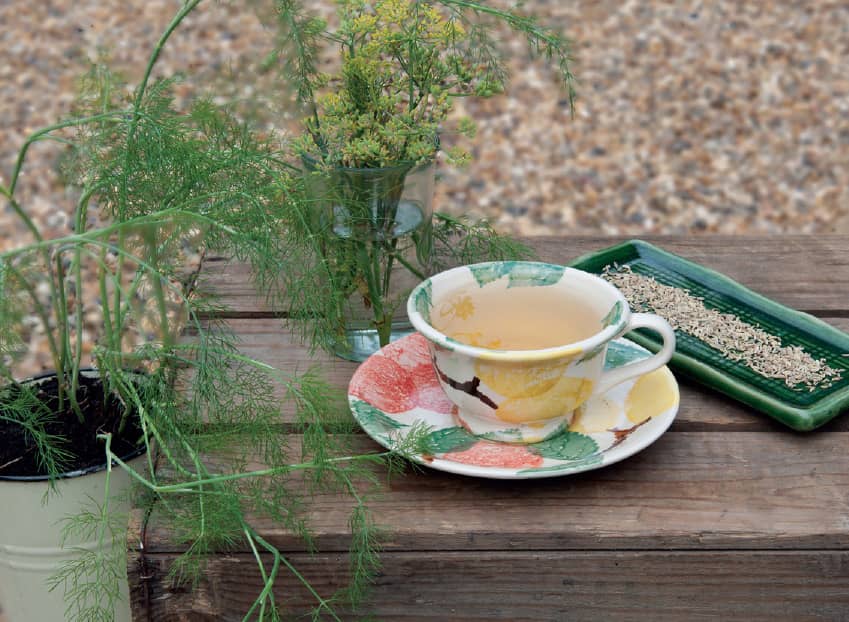
Pot marigold (Calendula officinalis) has cheerful bright orange or yellow flowers but their scent is an acquired taste and you will either love it or hate it, so smell before buying. It’s best know for its power to heal the skin and you can make your own cream by blending the petals with an emulsifier such as beeswax, together with glycerine and water. Simmer the mixture gently until it turns orange, and keep it in the fridge for treating burns, wounds and rashes. Very easy to grow in any soil and full sun, marigolds make a good cut flower. The petals are also edible and look fantastic in a green salad.
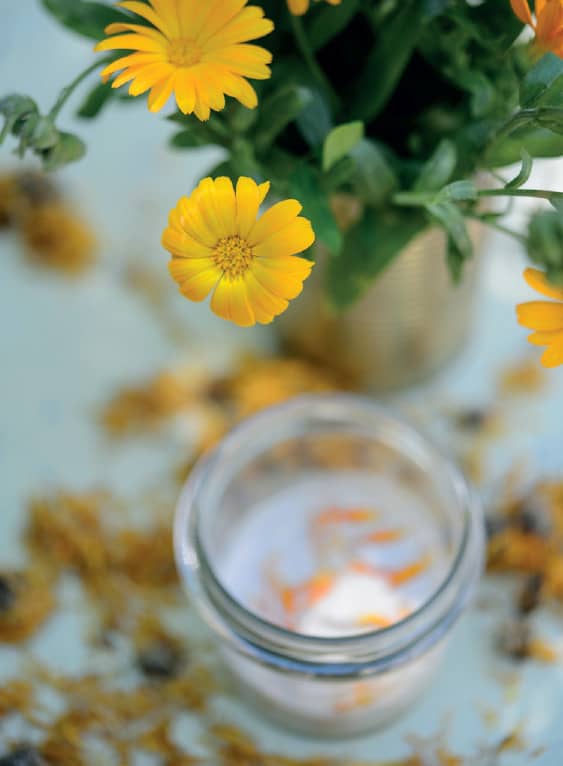
Marigolds are easy to grow from seed; their bright orange or yellow flower petals have myriad uses.
CHOOSING HERBS

Creeping thyme (Thymus serpyllum) has pretty pink flowers and aromatic foliage.
There is some overlap between the plants used in aromatherapy remedies and those we define as herbs. Broadly speaking, herbs are plants whose leaves can be used in food, flavouring, medicine and perfume, and you can grow a wide variety in the tiniest of spaces.
Today, we associate herbs with their culinary rather than their medicinal uses, but in days gone by they were predominantly cultivated for their healing properties. Herb gardens were originally planted in the monasteries of medieval Europe where monks and nuns cared for the sick and established “officinae” or apothecaries, providing treatment to alleviate all manner of ailments. This eventually led to the opening of commercial pharmacies in cities where tisanes, tinctures and pastes were prepared and sold as cures. The Latin word officinalis following the genus name of a plant, such as sage, Salvia officinalis, denotes its original use as a medicine. It seems to me that it is no small coincidence that the plants with this nomenclature are also the mostly highly scented. Presumably it was their perfume that first drew healers to investigate their medicinal properties.

A small raised bed devoted to herbs is a must for any keen cook and will also provide year-round colour and fragrance.
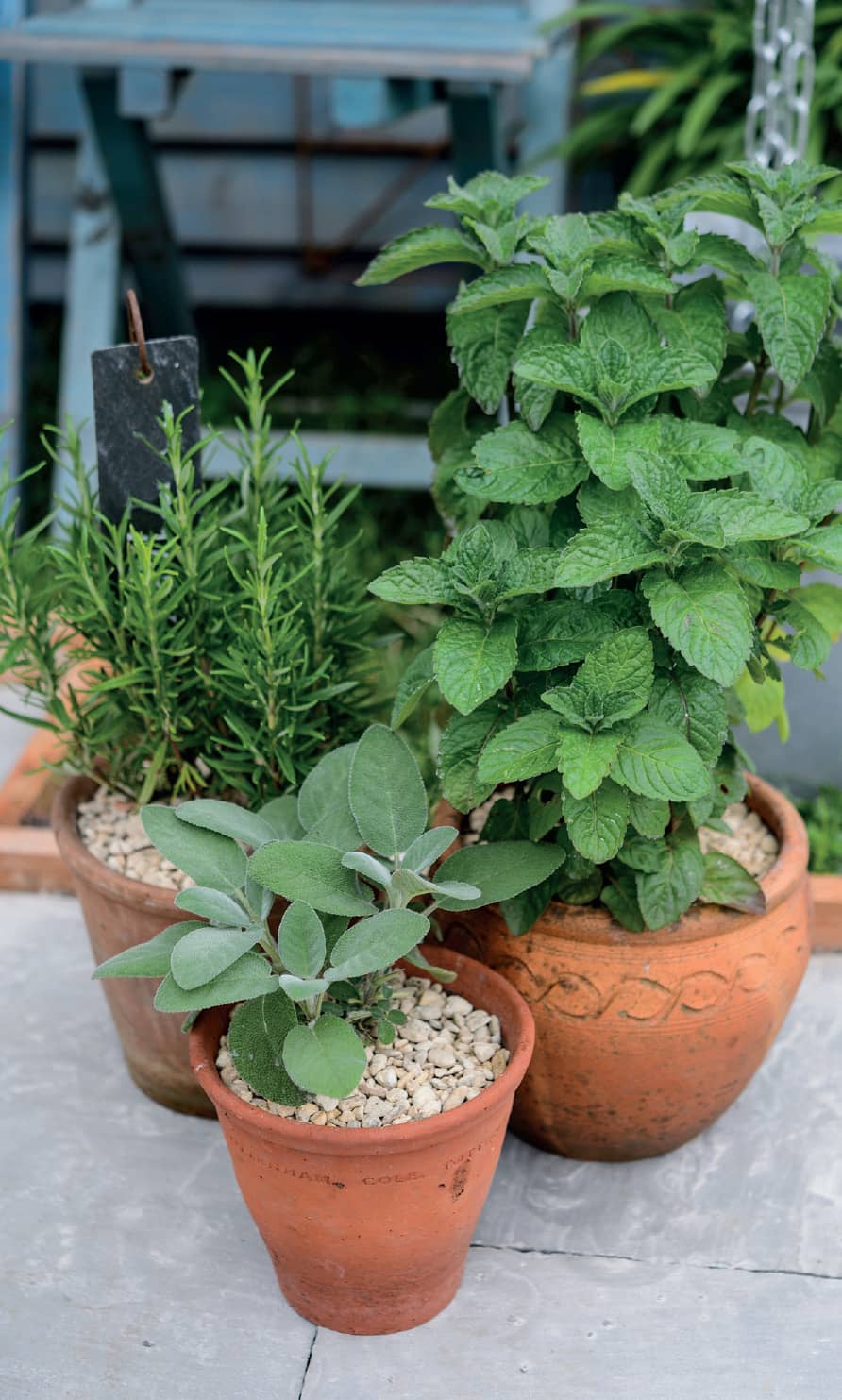
Rosemary, mint and sage are easy to grow in pots and all have therapeutic qualities.
CREATING A MINI APOTHECARY
The following herbs offer a pleasing combination of scents and flavours, which also work together as a well-considered purple-blue colour scheme. One plant of each variety in a shallow container or wall planter will provide you with enough choice for seasoning different types of food, preparing your own tisanes or blending perfumed bath salts and shower scrubs.
Rosemary (Rosmarinus officinalis) bears small pin-like evergreen leaves and clusters of purple-blue flowers in late spring and early summer. One of the best-smelling herbs for an instant pick-me-up and natural cold remedy, plunge a sprig in boiling water to help clear the sinuses. It can also be used for flavouring many savoury dishes and is delicious in a palate-cleansing sorbet or ice cream. Grow rosemary in free-draining soil and a sunny site, and clip it after flowering to reinvigorate growth and keep the plant bushy. The clippings can be dried to make an aromatic potpourri. Thyme can be used for a similar effect. Its antiseptic qualities are good for soothing sore throats. Look for Thymus ‘Silver Posie’, a compact variety with tiny purple-pink flowers and silvery grey leaves. Crush the leaves between your fingers to release their scent.

Rosemary has astringent qualities and can be used to alleviate colds. Recent research shows that it is also beneficial for memory retention.
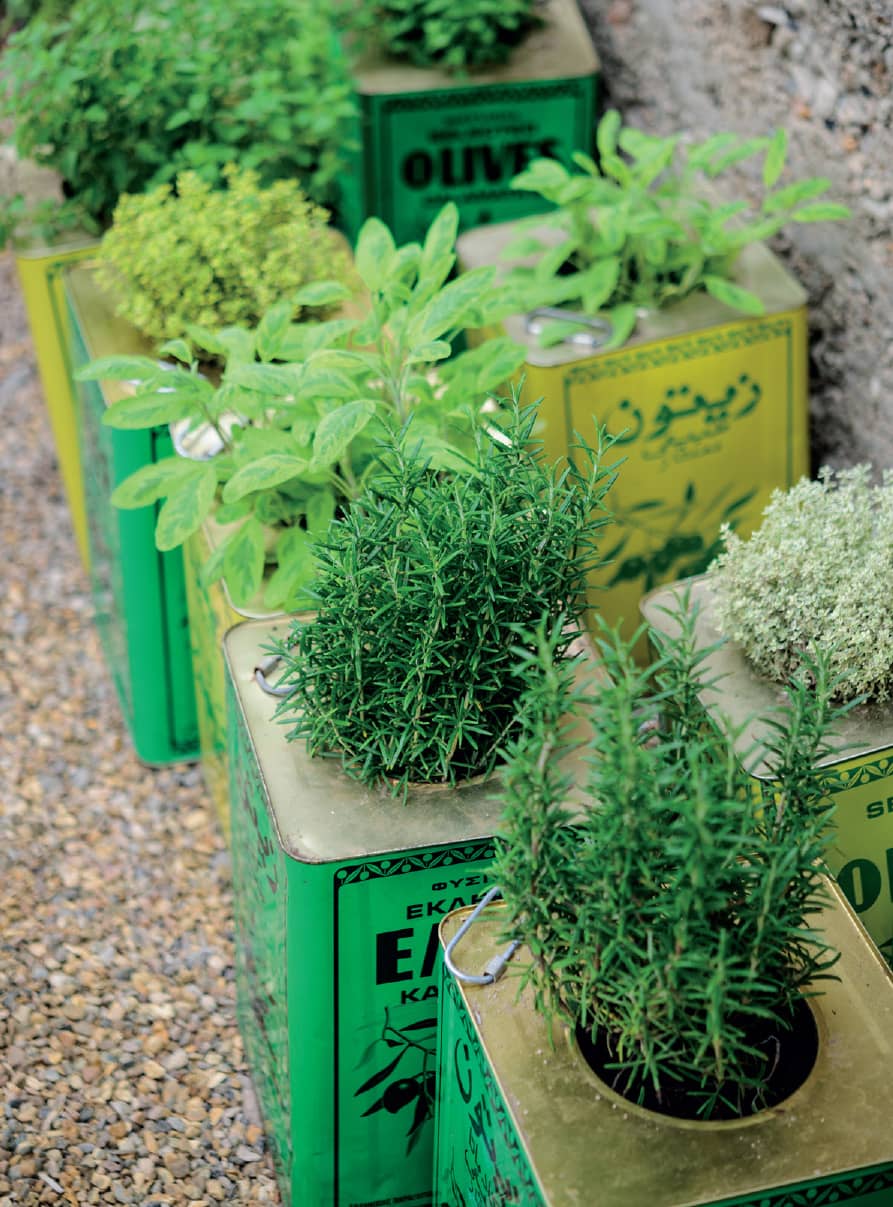
Create a herb garden in upcycled olive oil cans.
Lemon Balm (Melissa officinalis) is a widely available hardy perennial herb with a sharp lemony scent. Use the leaves in a tisane in times of stress to calm your nerves. Its nectar-rich flowers are a delicate pale purple and a favourite of bees, while its aromatic citronella fragrance is a useful natural mosquito deterrent. Lemon balm is very easy to grow in almost any soil and a sunny or part-shaded site, and it will spread and self-seed profusely. For an alternative herb with similar soothing properties, try lemon verbena (Aloysia citrodora), which also has citrus-scented leaves. Not as hardy as lemon balm, it may need winter protection in cold areas.

Sage (Salvia officinalis) offers the perfect combination of year-round green-grey foliage and pretty blue-purple summer flowers, both of which are edible. This plant has a distinctive scent with an astringent quality – somehow you know it’s going to do you good. Regarded as the king of herbs, it has a broad range of therapeutic properties. Sage tea, also known as the “thinkers’ tea” - the clue is in its name – is thought to improve concentration and boost serotonin levels. Like rosemary, sage is a shrub and needs a free-draining soil and full sun to thrive. Cut it back after flowering to maintain a bushy shape.
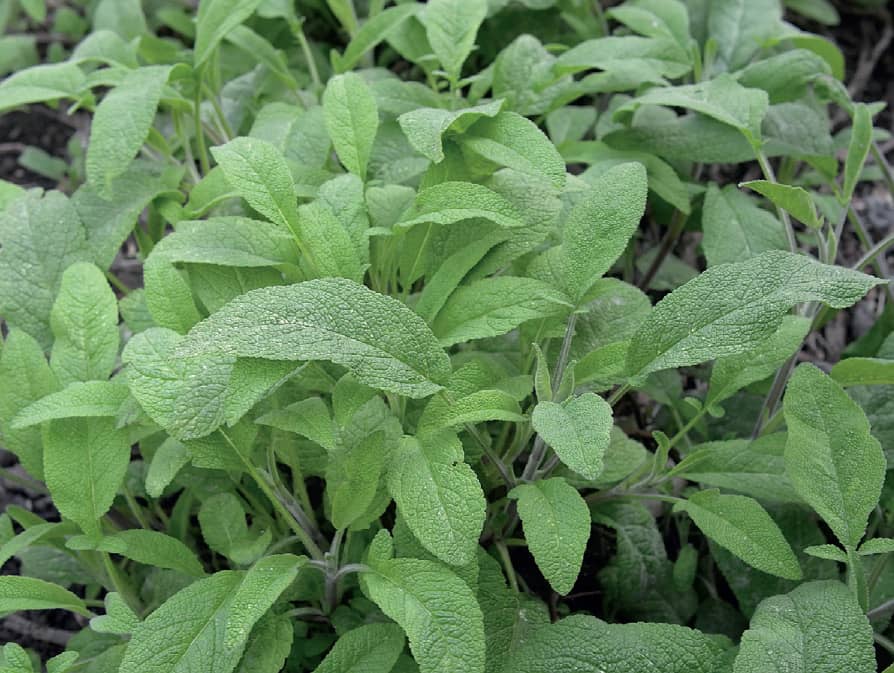
Sage helps to boost concentration and is now being used in trials to find a cure for dementia.
Mint (Mentha species) There are a number of different varieties of mint, each with its own delightful qualities. Peppermint (Mentha x piperita), spearmint (Mentha spicata) and pineapple or apple mint (Mentha suaveolens ‘Variegata’) are all worth growing for their individual scents and flavours. As it tends to be a bit of a thug in all its forms, grow it separately in a container to prevent it taking over and swamping other plants. A dedicated mint wall planter of all three is a simple and inexpensive solution (see herb project shown here).
Of the three mints mentioned, peppermint has the strongest flavour and is ideal for making tea or cordial; spearmint is milder but delicious with vegetables or in salads; pineapple mint, not surprisingly, has a fruity mint taste that works well in desserts and fruit-flavoured drinks. In all cases, mint is known to aid digestion and promote peaceful sleep. Added to that, peppermint and spearmint plants produce pretty spikes of purple and pink flowers that attract bees. Pineapple mint boasts pale pink blooms and cream and green variegated foliage that contrasts well with the plain green varieties. All mints grow in any reasonable soil and sun or shade, and they will provide you with scent and taste while looking and doing you good too.
